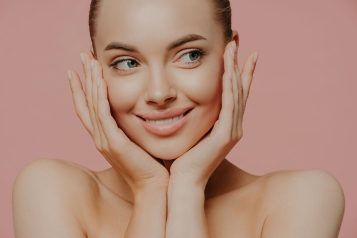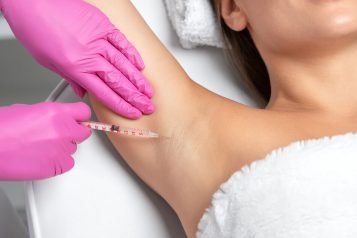Although often associated with male-pattern baldness, hair loss is common in women. It can be particularly distressing – not just from the shock of suddenly seeing more clumps of hair coming out in your brush or on the shower floor, but also from how it affects appearance and self-expression, confidence, and identity. For many people, hair is an extension of personality, showcased through the styles, cuts, and colors they choose. For many of us, how we cut, style, and color our hair is a way to show our personality to others and express something about ourselves.
 Photo Credit: Courtesy of Shutterstock
Photo Credit: Courtesy of Shutterstock
The Hair Growth Cycle
Understanding how our hair grows is crucial in understanding hair loss. First, you should know that each hair follicle operates independently, so your strands are all in different phases of the growth cycle – if they were synchronized, humans would go through regular periods of extreme hair loss where we’re entirely bald for months at a time. However, certain events with our health or in our environment can cause periods of synchronization – this can include dramatic changes to our diet, trauma, hormonal changes such as during pregnancy or menopause, or other illnesses. These can cause our hairs to move into the telogen phase (telogen effluvium.) of the growth cycle. The complete hair cycle includes the following:
- Anagen Phase (Growth): The cells in the root of the hair divide rapidly, anchoring the follicle deep into the dermal layer of the skin. This phase lasts 2 to 6 years, and hair grows about 1 cm per month.
- Catagen Phase (Transitional): This is a 2-3 week period during which growth stops and the hair prepares to shed. The root sheath shrinks and detaches from the blood supply.
- Telogen Phase (Resting): This phase lasts 3-4 months, during which the hair sheds and new hair begins to form.
 Photo Credit: Courtesy of Shutterstock
Photo Credit: Courtesy of Shutterstock
Types and Causes of Hair Loss
Hair loss is categorized into scarring and non-scarring types:
- Non-Scarring Hair Loss: The follicle remains intact and capable of regrowing hair. Common causes include genetic factors, nutritional deficiencies, hormonal changes, and physical stress on the hair. Conditions like androgenetic alopecia (male or female patterned hair loss), telogen effluvium, traction alopecia, and alopecia areata can be linked to aging, genetics, and diseases such as cardiovascular disease, diabetes, eczema, and thyroid issues.
- Scarring Hair Loss: This type permanently damages the follicle, preventing new hair growth. It may result from autoimmune disorders and inflammation. Treatments focus on addressing the underlying cause; once stabilized, options like hair transplants may be available.
 Photo Credit: Courtesy of Shutterstock
Photo Credit: Courtesy of Shutterstock
Treatment Options for Hair Loss
- Platelet-Rich Plasma (PRP) Therapy: This involves injecting blood platelets to accelerate healing and stimulate hair growth by increasing blood supply to the follicles.
- Low-Level Laser Therapy (LLLT): This uses red or near-infrared light to increase blood flow and stimulate hair follicles. It’s a non-invasive, FDA-approved technique that is effective in treating androgenetic alopecia.
- Hair Transplant Surgery: More invasive, this method moves hair follicles from a donor site to a balding part of the body through techniques like follicular unit transplantation (FUT) or extraction (FUE). FUT involves removing a strip of tissue under local anesthesia, isolating follicles, and transplanting them. FUE extracts individual follicles, leaving tiny scars less noticeable than FUT.
- Minoxidil: A topical medication you might know better as Rogaine stimulates new hair growth and slows balding. Available over the counter and by prescription, it works by widening blood vessels and extending the growth phase of hair.
- Vitamin Supplementation: Maintaining a healthy diet rich in iron and zinc, in addition to taking vitamins specifically formulated for hair loss like Nutrafol or Viviscal can help. It is also important to take Vitamin D if your levels are low.
- Anti-Dandruff Shampoo: Maintaining overall scalp health is crucial to creating an optimal environment for hair to grow. Many people have dandruff and even if it’s not visible, it’s important to wash the hair with an anti-dandruff shampoo containing zinc pyrithione at least 1x a week to keep the yeast count low.
Home Treatments and Care
It’s important to realize that there is not one home-run treatment for hair loss. The treatments all work synergistically to address different reasons why you might be losing hair. Treating the underlying cause of hair loss is crucial. Your hair and skin reflect what’s happening inside, meaning no surface-level intervention can treat or cure the cause. If your loss is attributable to a medical cause, you must first care for your health. It is essential to see your primary care provider and dermatologist to ensure you are safe and healthy and getting the right treatment for the underlying cause – diabetes, a thyroid issue, psoriasis, or something else.
 Photo Credit: Courtesy of Shutterstock
Photo Credit: Courtesy of Shutterstock
Addressing hair loss involves understanding its types, causes, and treatment options. While professional treatments are available, managing overall health and making lifestyle adjustments form the cornerstone of preventing and managing many kinds of hair loss. While you work with your care team to get your hair back in shape, you must protect any exposed scalp areas from the sun. SPF is crucial year-round for every part of your exposed skin, even your scalp. You can use a gentle sunscreen formulated for the face, or one made specifically for hair and scalp, usually in sprays or powders. You can also find many cute and functional hats and scarves with UPF or Ultraviolet Protection Factor. Look around, and you’ll likely find something that fits your tastes and needs.
For more information, visit Dr. Brian A. Levine's social media:

























